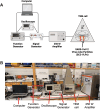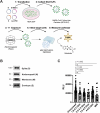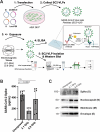Electromagnetic waves destabilize the SARS-CoV-2 Spike protein and reduce SARS-CoV-2 Virus-Like particle (SC2-VLP) infectivity
- PMID: 40374718
- PMCID: PMC12081674
- DOI: 10.1038/s41598-025-01896-1
Electromagnetic waves destabilize the SARS-CoV-2 Spike protein and reduce SARS-CoV-2 Virus-Like particle (SC2-VLP) infectivity
Abstract
Infection and transmission of Severe Acute Respiratory Syndrome Coronavirus 2 (SARS-CoV-2) continues to pose a global public health concern. Using electromagnetic waves represents an alternative strategy to inactivate pathogenic viruses such as SARS-CoV-2. However, whether electromagnetic waves reduce SARS-CoV-2 infectivity is unclear. Here, we adapted a coplanar waveguide (CPW) to identify frequencies that could potentially neutralize SARS-CoV-2 virus-like particles (SC2-VLPs). Treatment of SC2-VLPs at frequencies between 2.5 and 3.5 GHz and an electric field of 413 V/m reduced infectivity. Exposure of SC2-VLPs to a frequency of 3.1 GHz -and to a lesser extent, 5.9 GHz- reduced their binding to antibodies targeting the SARS-CoV-2 Spike S1 receptor-binding domain (RBD) but did not alter the total levels of Spike, Nucleocapsid, Envelope, or Membrane proteins in virus particles. These results suggest that electromagnetic waves alter the conformation of Spike, thereby reducing viral attachment and entry. Overall, this data provides proof-of-concept in using electromagnetic waves for sanitation and prevention efforts to curb the transmission of SARS-CoV-2 and potentially other pathogenic enveloped viruses.
Keywords: Coplanar waveguide; Electromagnetic waves; SARS-CoV-2; Sanitation; Spike; Transmission.
© 2025. The Author(s).
Conflict of interest statement
Declarations. Competing interests: The authors declare no competing interests.
Figures




Update of
-
Electromagnetic waves destabilize the SARS-CoV-2 Spike protein and reduce SARS-CoV-2 Virus-Like Particle (SC2-VLP) infectivity.bioRxiv [Preprint]. 2024 Sep 12:2024.09.11.612487. doi: 10.1101/2024.09.11.612487. bioRxiv. 2024. Update in: Sci Rep. 2025 May 15;15(1):16836. doi: 10.1038/s41598-025-01896-1. PMID: 39314332 Free PMC article. Updated. Preprint.
References
-
- Zaki, A. M., Van Boheemen, S., Bestebroer, T. M., Osterhaus, A. D. M. E. & Fouchier, R. A. M. Isolation of a novel coronavirus from a man with pneumonia in Saudi Arabia. N Engl. J. Med.367, 1814–1820 (2012). - PubMed
MeSH terms
Substances
Grants and funding
LinkOut - more resources
Full Text Sources
Medical
Miscellaneous

